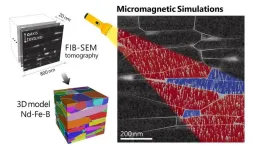(Press-News.org) The same geometric quirk that lets visitors murmur messages around the circular dome of the whispering gallery at St. Paul’s Cathedral in London or across St. Louis Union Station’s whispering arch also enables the construction of high-resolution optical sensors. Whispering-gallery-mode (WGM) resonators have been used for decades to detect chemical signatures, DNA strands and even single molecules.
In the same way that the architecture of a whispering gallery bends and focuses sound waves, WGM microresonators confine and concentrate light in a tiny circular path. This enables WGM resonators to detect and quantify physical and biochemical characteristics, making them ideal for high-resolution sensing applications in fields such as biomedical diagnostics and environmental monitoring. However, the broad use of WGM resonators has been limited by their narrow dynamic range as well as their limited resolution and accuracy.
In a recent study, Lan Yang, the Edwin H. & Florence G. Skinner Professor, and Jie Liao, a postdoctoral research associate, both in the Preston M. Green Department of Electrical & Systems Engineering in the McKelvey School of Engineering at Washington University in St. Louis, demonstrate a transformative approach to overcome these limitations: optical WGM barcodes for multimode sensing. Liao and Yang’s innovative technique allows simultaneous monitoring of multiple resonant modes within a single WGM resonator, considering distinctive responses from each mode, vastly expanding the range of measurements achievable.
WGM sensing uses a specific wavelelength of light that can circulate around the perimeter of the microresonator millions of times. When the sensor encounters a molecule, the resonant frequency of the circulating light shifts. Researchers can then measure that shift to detect and identify the presence of specific molecules.
“Multimode sensing allows us to pick up multiple resonance changes in wavelength, rather than just one,” Liao explained. “With multiple modes, we can expand optical WGM sensing to a greater range of wavelengths, achieve greater resolution and accuracy, and ultimately sense more particles.”
Liao and Yang found the theoretical limit of WGM detection and used it to estimate the sensing capabilities of a multimode system. They compared conventional single-mode with multimode sensing and determined that while single-mode sensing is limited to very narrow range – about 20 picometers (pm), constrained by the laser hardware – the range for multimode sensing is potentially limitless using the same setup.
“More resonance means more information,” Liao said. “We derived a theoretically infinite range, though we’re practically limited by the sensing apparatus. In this study, the experimental limit we found was about 350 times larger with the new method than the conventional method for WGM sensing.”
Commercial applications of multimode WGM sensing could include biomedical, chemical and environmental uses, Yang said. In biomedical applications, for instance, researchers could detect subtle changes in molecular interactions with unprecedented sensitivity to improve disease diagnosis and drug discovery. In environmental monitoring, with the capability to detect minute changes in environmental parameters such as temperature and pressure, multimode sensing could enable early warning systems for natural disasters or facilitate monitoring pollution levels in air and water.
This new technology also enables continuous monitoring of chemical reactions, as demonstrated in the recent experiments conducted by Yang’s group. This capability holds promise for real-time analysis and control of chemical processes, offering potential applications in fields such as pharmaceuticals, materials science, and the food industry.
“WGM resonators’ ultrahigh sensitivity lets us detect single particles and ions, but the potential of this powerful technology has not been fully utilized because we can’t use this ultrasensitive sensor directly to measure a complete unknown,” Liao added. “Multimode sensing enables that look into the unknown. By expanding our dynamic range to look at millions of particles, we can take on more ambitious projects and solve real-world problems.”
###
Liao J and Yang L. Multimode sensing by optical whispering-gallery-mode barcodes: A new route to expand dynamic range for high-resolution measurement. IEEE Transactions on Instrumentation and Measurement, online January 18, 2024. DOI: 10.1109/TIM.2024.3352712
This work was supported by the National Institutes of Health (R21EB030845).
END
Barcodes expand range of high-resolution sensor
2024-04-26
ELSE PRESS RELEASES FROM THIS DATE:
DOE Under Secretary for Science and Innovation visits Jefferson Lab
2024-04-26
NEWPORT NEWS, VA – On April 18, the U.S. Department of Energy’s Thomas Jefferson National Accelerator Facility welcomed Under Secretary for Science and Innovation Geraldine (Geri) Richmond for a tour of the lab and briefing on its research mission, innovation and STEM programs.
Throughout the day, much of the conversation centered on a common theme of how the lab is working to ensure it is a hub of engagement, partnership, and access for researchers, students, community leaders and others. Ensuring diverse communities have access to the programs, ...
Research expo highlights student and faculty creativity
2024-04-26
Hundreds of faculty, students and business leaders flocked to The University of Texas at Arlington for its second annual Research and Innovation Expo, an event designed to showcase the University’s research efforts.
“This is an event where we can showcase our research achievements and encourage everyone to learn about and engage with other investigators outside their own fields,” said Eileen Clements, interim executive director of the UT Arlington Research Institute and an organizer of the event.
Researchers learned how ...
Imaging technique shows new details of peptide structures
2024-04-26
By Leah Shaffer
A new imaging technique developed by engineers at Washington University in St. Louis can give scientists a much closer look at fibril assemblies, stacks of peptides like amyloid beta, most notably associated with Alzheimer’s disease.
These cross-β fibril assemblies are also useful building blocks within designer biomaterials for medical applications, but their resemblance to their amyloid beta cousins, whose tangles are a symptom of neurodegenerative disease, is concerning. Researchers want ...
MD Anderson and RUSH unveil RUSH MD Anderson Cancer Center
2024-04-26
The University of Texas MD Anderson Cancer Center and RUSH University System for Health today announced a partnership to create RUSH MD Anderson Cancer Center. The partnership represents advanced clinical and operational integration in the delivery of cancer care, providing RUSH patients greater access to cancer treatments and research considered among the best in the world.
MD Anderson is one of the nation’s leading cancer centers and its team of experts is devoted exclusively to cancer patient care, research, education ...
Tomography-based digital twins of Nd-Fe-b magnets
2024-04-26
1. NIMS has succeeded in simulating the magnetization reversal of Nd-Fe-B magnets using large-scale finite element models constructed based on tomographic data obtained by electron microscopy. Such simulations have shed light on microstructural features that hinder the coercivity, which quantifies a magnet’s resistance to demagnetization in opposing magnetic fields. New tomography-based models are expected to guide toward the development of sustainable permanent magnets with ultimate performance.
2. Green power generation, electric transportation, and other high-tech industries rely heavily on ...
People with rare longevity mutation may also be protected from cardiovascular disease
2024-04-26
A new study highlights possible cardiovascular health advantages in individuals with a rare condition known as growth hormone receptor deficiency (GHRD), also called Laron syndrome.
GHRD, which is characterized by the body’s impaired ability to use its own growth hormone and results in stunted growth, has been linked in mice to a record 40% longevity extension and lower risks for various age-related diseases. However, the risk of cardiovascular disease in individuals with GHRD has remained ...
Mobile device location data is already used by private companies, so why not for studying human-wildlife interactions, scientists ask
2024-04-26
When did you last go anywhere without your cell phone? From maps and weather apps to social media platforms, we give consent for our phones to trace our footsteps and behavior. These curated mobility data are often used for personalized advertisements. In a commentary, published April 26 in the journal Cell Reports Sustainability, scientists argue mobility data can offer so much more—it is key to understanding human-wildlife interactions for guiding policy decisions on sustainability-related issues and should be free and accessible for research.
As ...
Test reveals mice think like babies
2024-04-26
Are mice clever enough to be strategic?
Kishore Kuchibhotla, a Johns Hopkins University neuroscientist who studies learning in humans and animals, and who has long worked with mice, wondered why rodents often performed poorly in tests when they knew how to perform well. With a simple experiment, and by acting as “a little bit of a mouse psychologist,” he and his team figured it out.
“It appears that a big part of this gap between knowledge and performance is that the animal is engaging in a form of ...
From disorder to order: flocking birds and “spinning” particles
2024-04-26
Researchers Kazuaki Takasan and Kyogo Kawaguchi of the University of Tokyo with Kyosuke Adachi of RIKEN, Japan's largest comprehensive research institution, have demonstrated that ferromagnetism, an ordered state of atoms, can be induced by increasing particle motility and that repulsive forces between atoms are sufficient to maintain it. The discovery not only extends the concept of active matter to quantum systems but also contributes to the development of novel technologies that rely on the magnetic ...
Cardiovascular risk associated with social determinants of health at individual and area levels
2024-04-26
About The Study: The findings of this study of 26,000 participants from four large U.S. studies suggest that both individual- and area-level social determinants of health may be considered in future development of atherosclerotic cardiovascular disease risk assessment tools, particularly among Black individuals.
Authors: Yiyi Zhang, Ph.D., of Columbia University Medical Center in New York, is the corresponding author.
To access the embargoed study: Visit our For The Media website at this link https://media.jamanetwork.com/
(doi:10.1001/jamanetworkopen.2024.8584)
Editor’s ...







